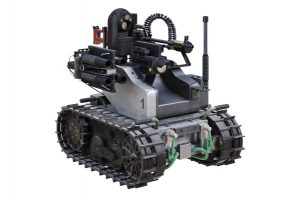It’s no secret that robots are everywhere. What used to be considered science fiction in many areas, is now reality. It’s no different in the military. The military has always been at the cutting edge of technology, so it should come as no surprise that some of the most advanced robots in the world are being built with military applications in mind. The use and design of military robots is on the rise.
While many military projects are shrouded in secrecy, some of them see the light of day, including robotic projects. From tiny robots to unmanned battle tanks, they are being found everywhere.
 In 2010, the U.S. Army began testing the Battlefield Extraction-Assist Robot, or BEAR, by Soldiers at the U.S. Army Infantry Center Maneuver Battle Lab at Ft. Benning, Georgia.
In 2010, the U.S. Army began testing the Battlefield Extraction-Assist Robot, or BEAR, by Soldiers at the U.S. Army Infantry Center Maneuver Battle Lab at Ft. Benning, Georgia.
Historically, it’s been the role of medics, who risk their lives often under enemy fire, to save their wounded comrades on the battlefield. According to Major General Steve Jones, commander of the Army Medical Department Center, “We have lost medics throughout the years because they have the courage to go forward and rescue their comrades under fire. With the newer technology, with the robotic vehicles we are using even today to examine and to detonate IEDs [improvised explosive devices], those same vehicles can go forward and retrieve casualties.”
There’s been no other options until BEAR came along. The BEAR can be controlled remotely by a motion-capture glove or specially-equipped rifle grip. A Warfighter can use the equipment to guide the robot to recover a wounded Soldier and bring him back, so a medic can safely conduct an initial assessment.
Another robot being used in the military is the MAARS, (Modular Advanced Armed Robotic System) which fits a lot of firepower into its tiny frame. The modular design allows the controllers to outfit it with a variety of armaments – from non-lethal lasers (designed to blind the enemy) to tear gas, and even a grenade launcher.
The Dogo, a small machine roaming around on two treads, could be mistaken for a toy – until it whips out its Glock. Within its body, it not only houses a camera, allowing for remote reconnaissance, but also a 9-millimeter pistol. It weighs 26 pounds and can climb stairs and other obstacles. The operator gets a 360-degree view of the surroundings via six video cameras, while another two cameras are mounted along the pistol barrel.
Already in use, are unmanned aerial vehicles that conduct surveillance and to fire missiles. Drones minimize collateral damage and don’t require putting troops at risk. They are also less costly. They are operated by humans from the safety of a domestic operations center, while the target could be in far flung, dangerous places.
While the drones are working from high above, other robots operate on the ground in battlefields worldwide. The U.S. Military relies on bomb-squad robots to inspect and defuse possible explosives. The remote-controlled machines move via tank tread and feature infrared vision, multiple cameras, floodlight and mechanical arms in order to locate and neutralize explosive devices, while the operators stay a safe distance away.
The RoboBee may be the tiniest military robot in development. Developed by Harvard’s Microbiotics Laboratory, this tiny robot is capable of hovering. Theoretically, the RoboBee could represent an important step towards insect-sized robots capable of transmitting video or audio. This could allow military intelligence to truly be a fly on the wall in meetings where a human could not go.
The future of autonomy in the military could include unmanned cargo delivery; micro-autonomous air/ground systems to enhance operational situational awareness; and manned and unmanned teaming in both air and ground maneuvers.
Technology is changing the face of the military, and the military robots that will be developed will require lenses with precise accuracy and imaging. Universe Optics employs teams of dedicated designers and engineers; coupled with state-of-the-art manufacturing, you can guarantee that your design will exceed your expectations.